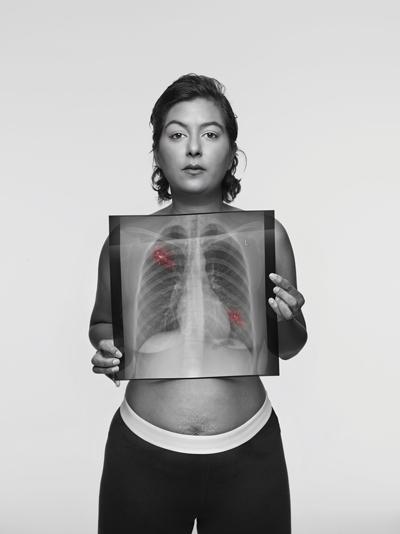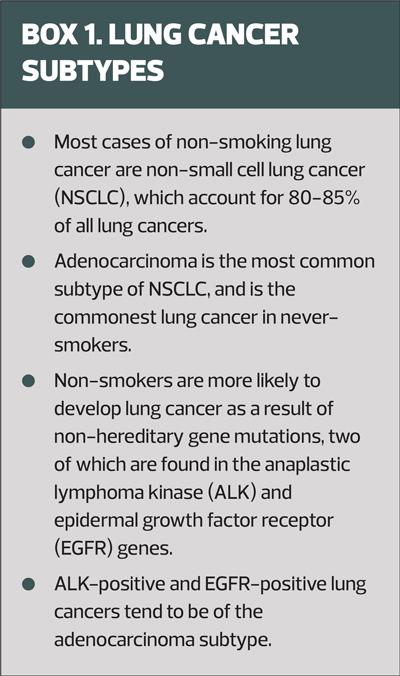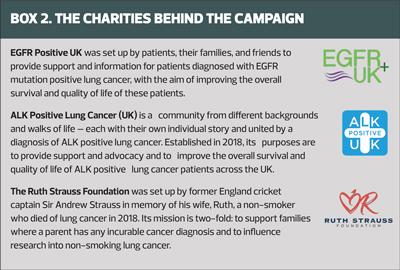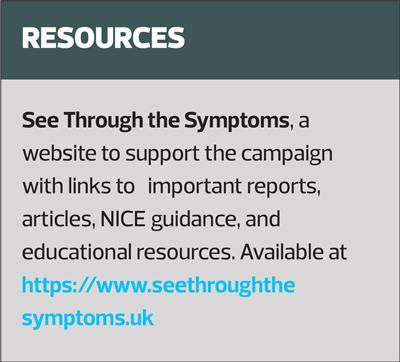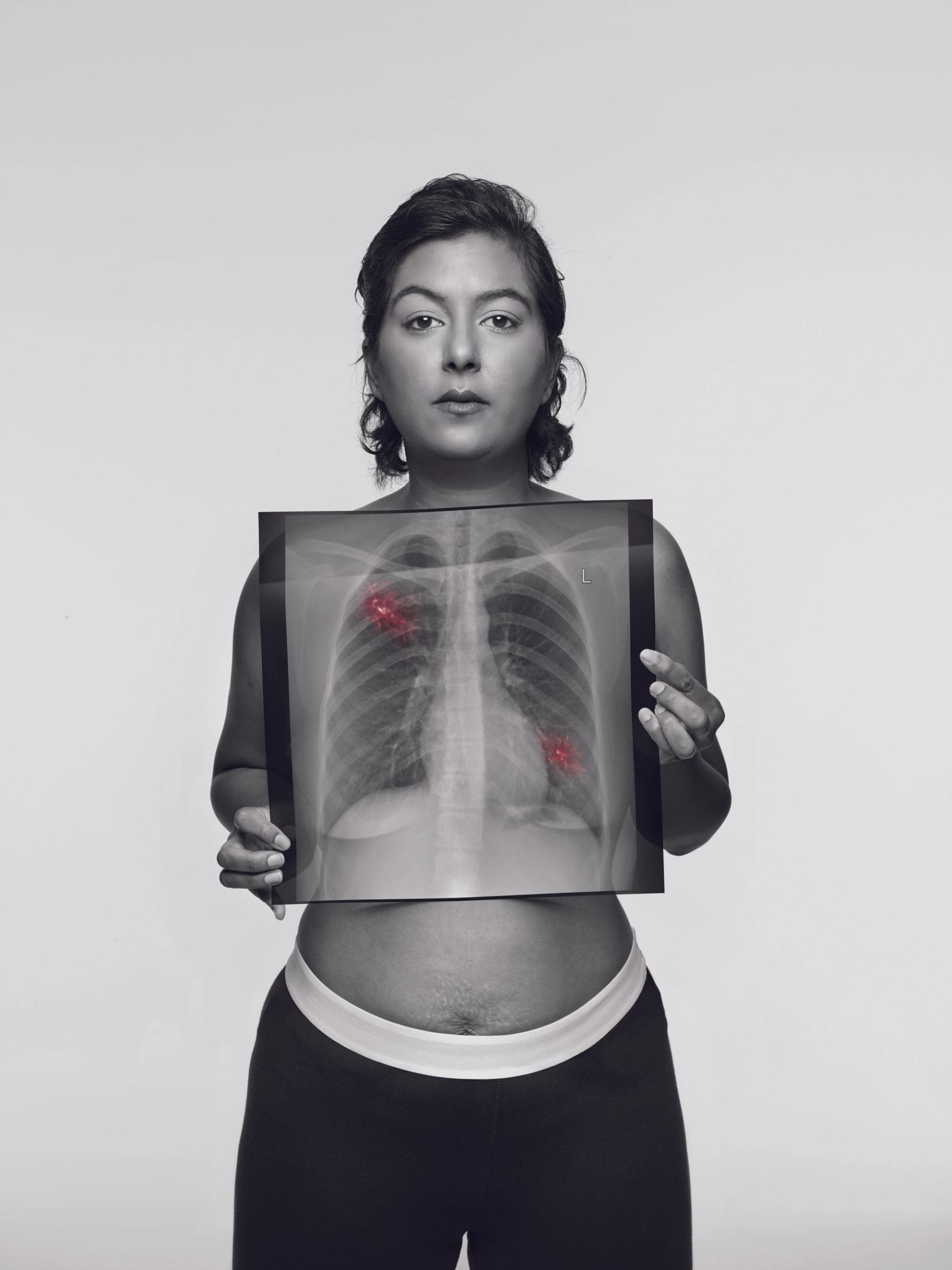
Raising awareness of lung cancer in never-smokers
Practice Nurse 2023;53(6):12-14
Practice Nurse 2023;53(6):12-14
Lung cancer in people who have never smoked causes more deaths than you may realise, and it is crucial that you are alert to symptoms that should trigger further investigation
Non-smoking lung cancer is among the deadliest of cancers. Lung cancer is the biggest cause of cancer deaths in England: around 35,000 people die from lung cancer in England each year.1 And lung cancer in never-smokers – defined as people who have smoked less than 100 cigarettes in their lifetime – is now the eighth most common cause of cancer-related deaths in the UK.2
It is estimated that in the UK, nearly 6,000 people who have never smoked die of lung cancer each year: that’s more deaths from lung cancer in never-smokers than there are deaths from lymphoma (~5,200), leukaemia (~4,500), or ovarian cancer. More than 57% of lung cancer patients in the UK are diagnosed at stage 3 or 4 – when their cancer is advanced and treatment which could cure them is no longer an option.3 Data from patient organisations suggest that in the never-smoking population, this rises to nearly 90%.4
Three lung cancer charities have therefore launched a campaign urging primary care healthcare professionals (HCPs) to recognise symptoms of lung cancer in people who have never smoked and refer them for investigation.
The See Through the Symptoms campaign was jointly developed by EGFR Positive UK, ALK Positive UK and the Ruth Strauss Foundation. It features photographs by renowned photographer Rankin, whose mother died from lung cancer in 2005.
The series of portrait images show nine patients – eight of whom have never smoked and one, an occasional smoker – all diagnosed with stage IV lung cancer. For all of them, diagnosis took many months. Four of the nine patients were diagnosed in their 20s and 30s.
See Through the Symptoms has been running throughout November to coincide with Lung Cancer Awareness Month. It aims to educate and raise awareness of lung cancer in non-smokers and never-smokers and encourage HCPs to act on symptoms, regardless of a person’s age or smoking status.
Although patients with non-smoking lung cancer can present with typical symptoms, they are often misdiagnosed because they do not fit the profile of a typical lung cancer patient – they tend to be younger, female and a non-smoker.
SYMPTOMS SUGGESTIVE OF LUNG CANCER
The symptoms of lung cancer are often similar in both smokers and non-smokers. They include:
- A persistent cough
- Fatigue (duration >4 weeks)
- Hoarseness
- Ongoing pain in the chest, neck, upper back or shoulder
- Unintentional weight loss and loss of appetite
- Persistent or recurrent chest infection
- Unexplained haemoptysis
- Persistent enlarged supraclavicular or cervical lymph nodes
- Unexplained, persistent shortness of breath5
If you see a patient with persistent symptoms for which there is no obvious cause, request a chest X-ray or a CT scan. Swift referral to further investigation could catch the disease while it is still curable.
Dr Anthony Cunliffe, Lead GP Adviser for Macmillan Cancer Support, said: ‘It’s so important that, as primary care clinicians, we still consider the possibility of a diagnosis of lung cancer in patients even when they have never smoked.’
NICE guidelines6 recommend that clinicians offer or consider a chest X-ray under the Faster Diagnosis Standard for patients with persisting, unexplained symptoms to assess for lung cancer in people aged 40 and over if they have two or more of the unexplained symptoms above (or if they have ever smoked and have one or more of these symptoms).
The sensitivity of typical symptoms in non-smokers is half that of those who do smoke, but lung cancer should still be considered as a possibility: lung cancer in people who have never smoked is under-recognised, rather than uncommon.2
AGE MATTERS
Although NICE guidelines are clear about the age threshold for an urgent chest X-ray, it should be remembered that lung cancer can affect younger patients too.
While the peak age for lung cancer cases is between 85 and 89 years, lung cancer can and does occur in younger patients, with 100–240 cases reported in patients in their mid-30s to mid-40s, respectively, many of whom will not survive.7
THE IMPORTANCE OF EARLY DIAGNOSIS
The importance of improved clinical awareness, especially in primary care, must not be underestimated. Being able to identify the signs and symptoms of lung cancer, and to know when a person should be referred is an essential part of improving outcomes.3
Many of the symptoms that could raise suspicion of lung cancer are non-specific, and may not be raised by patients if they have what appears to be a more pressing medical problem. It is therefore important to treat patients holistically, and to allow patients to talk about a range of symptoms which, when considered together, may indicate that lung cancer should be suspected.3
Patients recall having new symptoms for many months in the year before their diagnosis, irrespective of their disease stage once diagnosed. Late diagnosis has a significant impact on survival rates, but up to 56% of people are only diagnosed after hospital admission via A&E.3
Diagnosis lung cancer at an early stage can lead to more treatment options and better outcomes for patients. Almost 9 out of 10 (88%) of lung cancer patients will survive for at least a year if diagnosed at stage I, compared with 19% for people diagnosed with the most advanced stage of disease. However, data from the Lung Cancer Audit show that 57% of patients had stage IIIB or IV at the point of presentation, by which point, the cancer becomes harder to treat and outcomes are poorer than when the disease is diagnosed at stage I or II.3
RISK FACTORS FOR LUNG CANCER IN NEVER-SMOKERS
Non-smokers are more likely to have developed lung cancer as a result of a genetic mutation or abnormality. Two genetic mutations that can cause lung cancer are found in the ALK and EGFR genes (see Box 1). In both cases, the mutations are not hereditary but develop later in life.
While smoking remains the largest modifiable risk for lung cancer in the UK, and is strongly associated with small-cell lung cancer, the causes of lung cancers in never-smokers may include:
- Second-hand tobacco smoke – passive smoking
- Exposure to carcinogenic substances in the workplace (more common in men than women)
- Environmental causes, such as outdoor pollution.2
However, identifying the precise cause of cancer in individual patients is difficult due to the overlapping nature of risk factors and exposures.2
CONCLUSION
The overall incidence of lung cancer in people who have never smoked is on the rise. The fact that almost 90% of cases are diagnosed at an advanced stage suggests that non-smoking lung cancer is under-recognised among healthcare professionals.
People who don’t smoke usually don't consider lung cancer as a possibility, even when they have persistent unexplained symptoms. A patient who does not consider themselves to be at risk of lung cancer often ignores symptoms, and may resist visiting their GP. They may, however, mention their symptoms to you, or tell you they have been using medicines bought from their local pharmacist, or sought treatment from a physiotherapist.
A key aim of the campaign is to alert all HCPs to the possibility that a patient who does not respond to treatment as expected or is a frequent user of medicines such as cough mixture or painkillers, may need to be investigated further. The threshold to refer a person with a suspicion of lung cancer for a chest X-ray needs to be very low.3
REFERENCES
1. Navani N, Baldwin DR, Edwards JG, et al. Lung Cancer in the United Kingdom. J Thoracic Oncol 2022;17(2):186-193
2. Bhopal A, Peake MD, Gilligan D, Cosford P. Lung cancer in never-smokers: a hidden disease. J Royal Soc Med 2019;112(7):269-271
3. UK Lung Cancer Coalition. Early diagnosis matters; 2020. https://www.uklcc.org.uk/sites/default/files/2021-06/UKLCC-Early-Diagnosis-Matters.pdf
4. Abbott J, Beattie K, Montague D. The Role of UK Oncogene-Focussed Patient Groups in Supporting and Educating Patients with Oncogene-Driven NSCLC: Results from a Patient-Devised Survey. Oncol Ther 2021;9(1):187-193
5. Evison M, Grundy S, Bailey S, et al for the Lung Cancer Clinical Expert Group. Differentiation of the Cs in lung cancer – Cancer vs COVID; 2020. https://www.brit-thoracic.org.uk
6. NICE NG12. Suspected cancer: recognition and referral; 2015 (updated October 2023). https://www.nice.org.uk/guidance/ng12
7. Cancer Research UK. Lung cancer incidence statistics. https://www.cancerresearchuk.org/health-professional/cancer-statistics/statistics-by-cancer-type/lung-cancer/incidence#heading-One
Related articles
View all Articles
